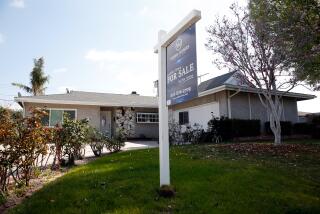Home prices post sharp increases in January
Tight housing supply and strong demand in January pushed a leading home price index to notch its sharpest annual increase in more than six years.
The price jumps in big U.S. cities are driving down negative home equity and giving a boost to the new-home market, new data show. The continuing housing recovery should contribute to positive growth as the economy grapples with declines in government spending, analysts said.
The Standard & Poor’s/Case-Shiller index of 20 U.S. cities recorded an 8.1% year-over-year increase in January, underscoring the vigor of the recent recovery. It was the biggest year-over-year jump since summer 2006, when home prices peaked during the subprime lending boom. The index was essentially flat compared with December, increasing just 0.1%.
Yet some economists remain concerned that the price gains still depend too much on low mortgage interest rates and the new trend of big corporate investment in housing.
With sources of mortgage credit still tight for everyday buyers, the recovery could stall once cheap money and investor demand wane, said Anthony B. Sanders, a finance professor at George Mason University.
“Who is going to step into the void?” Sanders said.
The index, created by economists Karl E. Case and Robert J. Shiller, is widely considered the most reliable read on home values. It compares the latest sales of detached houses with previous sales, accounting for factors such as remodeling.
Case, a Wellesley College professor, said Tuesday that the recovery appeared healthy. Although the 8.1% increase is sizable, it does not compare to the double-digit increases recorded during the housing bubble. Prices, as tracked by the index, still remain about 30% off their peak months reached in summer 2006.
“If you look at the changes that we have been through, on the way up and down, we doubled and tripled prices going up last time,” Case said. “So these are nice numbers, but they are not yet — and hopefully they won’t be — any sort of boom-time numbers.”
Although investor demand and a lack of inventory are driving prices higher, people’s long-term price gain expectations are not nearly the same as they were during the boom years, according to recent surveys Case and Shiller have conducted. That should help keep speculation in check, Case said.
Southern California, the Bay Area and other California markets saw sharp price increases and are now clearly in recovery. Over the year, the Los Angeles metro area was up 12.1%, San Diego up 9.8% and San Francisco up 17.5%.
Mark Zandi, chief economist for Moody’s Economy.com, said the housing price gains should translate into economic growth as construction and home building take off. This boost from real estate should help offset government spending cuts.
“It’s all still very positive — the price gains are coming off very low levels,” Zandi said. “These very low inventory levels are going to juice up price gains this year, probably into next.”
All 20 cities tracked by the index posted year-over-year gains in January, with Phoenix posting the largest increase: 23.2%.
Although overall the gains were positive, sharp increases in markets saturated with investors, such as Phoenix, could drive speculation, said Dean Baker, co-director of Center for Economic and Policy Research.
“I really do worry about some of these markets,” Baker said.
Sanders, the George Mason economist, noted that the recovery was distinct from earlier housing rebounds because of the presence of investors that include traditional mom-and-pop buyers as well as Wall Street players such as the Blackstone Group, Oaktree Capital Management and others.
These players are snapping up homes to rent and hold for long-term price gains. Although representatives of these firms say they are serving the public good by fueling the recovery and sprucing up run-down homes, critics caution that they could be putting housing on unstable ground.
“We are almost moving toward a more corporate form of ownership,” Sanders said. “That does not bode well for a vibrant recovery, and so I would expect to see another slowing, or home-price drop.”
A separate report Tuesday showed the number of distressed properties that may soon hit the market declined in January, according to real estate data provider CoreLogic.
The Irvine firm calculates pending supply by estimating the number of homes that are in the foreclosure process, are owned by lenders or have seriously delinquent loans. This shadow inventory has dropped 28% since it peaked at 3 million homes in January 2010. California saw its supply of serious delinquencies — homes with a loan 90 days or more past due — fall 33% over the year. That was the second-largest decline behind Arizona.
Another report, from the Commerce Department, said newly built homes sold at a seasonally adjusted annual rate of 411,000 in February. That was 4.6% below the previous month but up 12.3% from a year earlier. New-home sales numbers can be volatile month to month, and overall, the market for new construction has improved this year with builders increasing prices.
Times staff writer Andrew Khouri contributed to this report.
More to Read
Inside the business of entertainment
The Wide Shot brings you news, analysis and insights on everything from streaming wars to production — and what it all means for the future.
You may occasionally receive promotional content from the Los Angeles Times.










